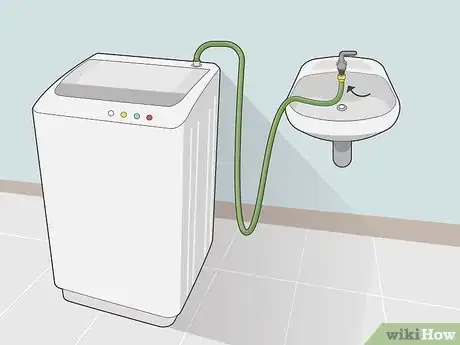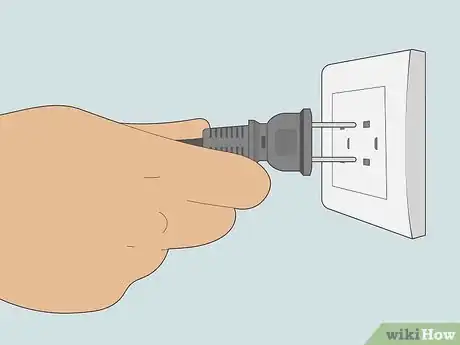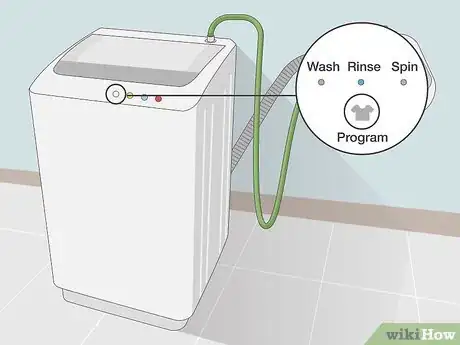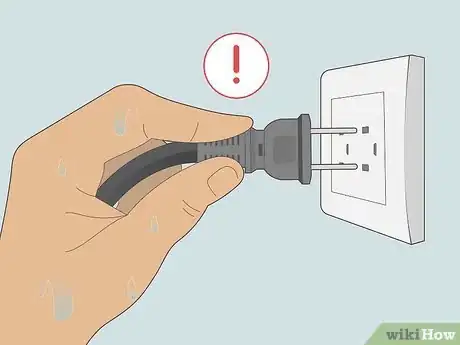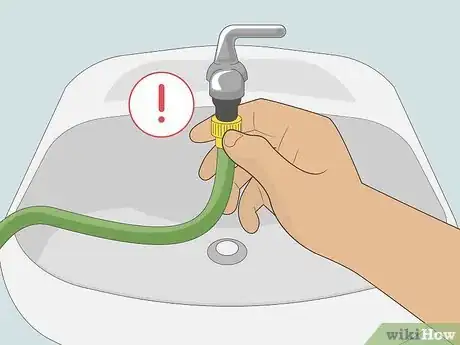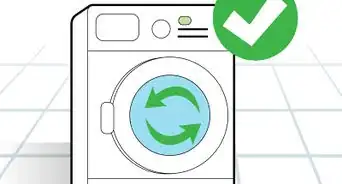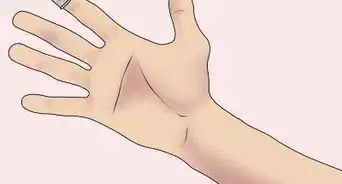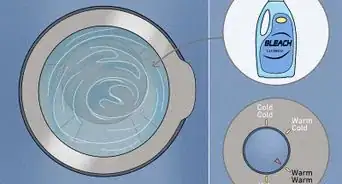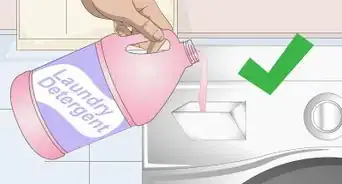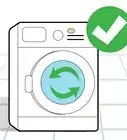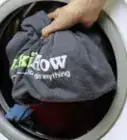This article was co-authored by wikiHow Staff. Our trained team of editors and researchers validate articles for accuracy and comprehensiveness. wikiHow's Content Management Team carefully monitors the work from our editorial staff to ensure that each article is backed by trusted research and meets our high quality standards.
This article has been viewed 88,081 times.
Learn more...
A portable washing machine can be a big convenience. You don't have to worry about machines filling up at laundromats or your apartment's laundry room, and it's cheaper and smaller than a full-sized machine. Using a portable washer is fairly simple. You use water from your sink to fill and drain the washer, washing small loads of clothing at a time. Make sure to read your instruction manual before filling the washer, as precise instructions vary from machine to machine.
Steps
Loading the Machine
-
1Load your laundry. For the most part, you will have to do small loads with a portable washer. Your machine's instruction manual should have specific instructions regarding how much clothing it can hold. Most machines cannot hold more than 10 pounds.[1]
- Place your clothing into the washer. You can separate loads by color and fabric type the same way you would when using a normal washing machine. Liquid detergent tends to work best with portable washing machines.
- It's a good idea to add some liquid fabric softener, as portable washing machines only do spin cycles.[2]
-
2Hook up the hose to a faucet. There should be a hose attached to your portable washer. This hose will be screwed onto your kitchen's faucet in order to fill the machine with water to wash the clothing. Hook the hose up to a faucet in your kitchen or bathroom and turn the water on.[3]
- Use the water temperature that works best for your clothing type. For example, wash bright clothing in cold water.
- Some machines may have two different hoses: one to load the water, and the other to drain it afterwards. Refer to your instruction manual to make sure you're plugging the right hose into the kitchen sink.
- Most machines will have a line inside the washer marking how much water to add. Do not add water above this line as this can interfere with how the machine works and damage your clothing.[4]
Advertisement -
3Plug in the appliance and start the wash. When you load your clothes and fill the machine, make sure you choose an area with an outlet nearby. You need to plug in the machine for it to work. Once the clothing and water is loaded, you can plug in the machine and start the wash.[5]
- Most machines have a timer, where you can decide how long you want to wash your clothes. In general, the dirtier the clothing, the longer your wash cycle should be. There will also be a switch to turn to get the machine to start the wash.[6]
- Make sure to plug your machine directly into the wall. Portable washing machines do not work with power adapters or extension cords.[7]
Washing Your Clothes
-
1Drain the dirty water. After your wash cycle is done, there should be another nozzle that will drain the dirty water. If you're not sure which nozzle to use, check your instruction manual. Place this nozzle in the sink and allow all the dirty water to drain.[8]
- Make sure the nozzle is securely in the sink. If the nozzle falls out, you could end up with dirty water all over your floor.
-
2Rinse the clothes again, if your machine requires it. Some machines do not have a rinse cycle. Once you've drained the water, you can remove and dry your clothing. However, other machines require a specific rinse cycle. If your machine requires a rinse cycle, fill the machine with cold, clean water and set it to rinse.[9]
- You may have to drain the water again after the rinse cycle is over.
-
3Dry your clothes. If you have a portable dryer, you can dry your clothes there. You can also use a regular drying machine or air dry your clothes. If you don't have a dryer, there are other ways to dry your clothes.[10]
- It can save money to air dry your clothes on a clothing line or drying rack. However, this does not work as fast as a regular dryer or portable dryer.
Avoiding Common Mistakes
-
1Read your instruction manual before using the machine. While portable washing machines are all somewhat similar, precise instructions will vary. Before using your machine, read your instruction manual closely. You want to make sure you follow the rules for your machine closely.[11]
-
2Make sure to dry your hands before handling the machine's plug. It's easy to get your hands wet when handling laundry. To protect yourself form electric shock, dry your hands thoroughly before plugging in or unplugging the machine.[12]
-
3Avoid washing coats. Heavy items, like coats, are generally too bulky for a portable washing machine. You will have to get such items dry cleaned or wash them in a regular washing machine.[13]
-
4Make sure everything is in place. You want to make sure all the nozzles are screwed on tightly. You should also be vigilant about not overfilling the machine. You do not want to be left with a soapy mess to clean up.
Community Q&A
-
QuestionCan I use fabric softener?
 Shelly DiphillipoCommunity AnswerYes, anything you use in a regular washer can be used in a portable washer, you would just use less of it.
Shelly DiphillipoCommunity AnswerYes, anything you use in a regular washer can be used in a portable washer, you would just use less of it. -
QuestionHow do I spin the clothes? Do I have to wring them out?
 Community AnswerI bought one that has a separate small spin cycle, and an inlet for the water hose if you want to add water to rinse as clothes spin. You can also be washing another load of laundry in the washer side. I love the spin cycle, it gets clothes almost dry!
Community AnswerI bought one that has a separate small spin cycle, and an inlet for the water hose if you want to add water to rinse as clothes spin. You can also be washing another load of laundry in the washer side. I love the spin cycle, it gets clothes almost dry! -
QuestionCan I manually fill the machine with water without hooking it up to a sink?
 Community AnswerYes. You can use a bucket, a jug, or (if it's nearby) a handheld shower-head.
Community AnswerYes. You can use a bucket, a jug, or (if it's nearby) a handheld shower-head.
References
- ↑ http://www.apartmentguide.com/blog/portable-washing-machines-no-laundry-room-required/
- ↑ https://www.youtube.com/watch?v=90qSKkBuMaw
- ↑ http://www.apartmentguide.com/blog/portable-washing-machines-no-laundry-room-required/
- ↑ https://www.youtube.com/watch?v=90qSKkBuMaw
- ↑ http://www.apartmentguide.com/blog/portable-washing-machines-no-laundry-room-required/
- ↑ https://www.youtube.com/watch?v=90qSKkBuMaw
- ↑ http://www.homedepot.com/catalog/pdfImages/ce/ce5e6142-b5a3-49df-b7e7-c0b4664733e9.pdf
- ↑ https://www.youtube.com/watch?v=90qSKkBuMaw
- ↑ http://www.apartmentguide.com/blog/portable-washing-machines-no-laundry-room-required/
- ↑ http://www.apartmentguide.com/blog/portable-washing-machines-no-laundry-room-required/
- ↑ http://www.apartmentguide.com/blog/portable-washing-machines-no-laundry-room-required/
- ↑ http://www.homedepot.com/catalog/pdfImages/ce/ce5e6142-b5a3-49df-b7e7-c0b4664733e9.pdf
- ↑ http://www.homedepot.com/catalog/pdfImages/ce/ce5e6142-b5a3-49df-b7e7-c0b4664733e9.pdf
About This Article
A portable washing machine is a simple way to use the water from your sink to wash small loads of clothing. To use one, first, place a small load of clothes into the washer along with some liquid detergent. Then, hook the hose up to your kitchen faucet so it can fill with water. Make sure you only add the amount of water recommended on the box, since adding too much can cause the machine to overflow. Once it’s filled, plug the cord into an outlet and start the wash. After the cycle is done, place the end of the drain hose into the sink and drain the dirty water. Depending on your machine, you may need to rinse the clothes again with clean water. Otherwise, you can simply take your clothes out and hang them up to dry. To learn how to avoid common washing mistakes, read on!

